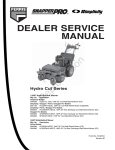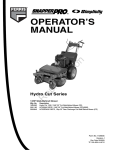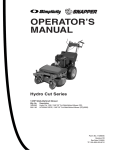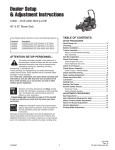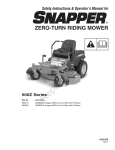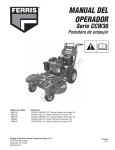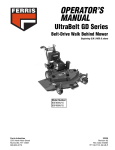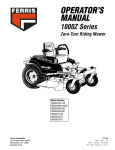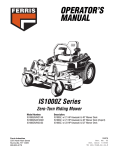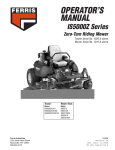Download Simplicity 1694562 Operator`s manual
Transcript
N ep o ro t fo du r ct io n OPERATOR’S MANUAL Hydro Cut Series 13HP Walk-Behind Mower R Mfg. No. Description Simplicity Models 1694562 Hydro Cut 1332, 13HP 32” Cut Walk-Behind Mower (CE) Simplicity / Snapper / Ferris / Snapper Pro Models 5901182 HC32KAV13ECE, 13HP 32” Cut Walk-Behind Mower (CE)(2006) Simplicity / Ferris / Snapper Pro Models 5900846 HC32RDKAV13ECE, 13HP 32” Rear Discharge Cut Walk Behind Mower (CE) Snapper Pro Models 5900895 SP32RDKAV13ECE, 13HP 32” Rear Discharge Cut Walk Behind Mower (CE) 5900896 SP32KAV13ECE, 13HP 32” Cut Walk-Behind Mower (CE) 16HP Walk-Behind Mower Mfg. No. Description Ferris Models 5900989 Hydro Cut 1632, 16HP 32” Cut Walk-Behind Mower (CE) 5900990 Hydro Cut 1632 Rear Discharge Cut Walk Behind Mower (CE) Form No. 5102315 Revision M N ep o ro t fo du r ct io n R THIS PAGE INTENTIONALLY BLANK Table of Contents Safety Rules & Information ............................... 2 Identification Numbers ...................................... 5 Safety Decals & Icons ........................................ 6 Features & Controls ........................................... 8 Operation........................................................... 10 General Operating Safety .....................................10 Checks Before Starting .........................................10 Starting the Engine ...............................................11 Driving the Mower .................................................11 Operating On A Slope...........................................11 Stopping the Mower ..............................................12 Mowing ..................................................................12 Pushing the Mower by Hand ................................12 Storage .................................................................13 Starting After Long Term Storage .........................13 Cutting Height Adjustment ....................................14 Ground Speed Control Lever Adjustment .............15 Control Functions ....................................................8 Safety Interlock System ........................................10 WARNING N ep o ro t fo du r ct io n NOTE: In this manual, “left” and “right” are referred to as seen from the operating position. WARNING You must read, understand and comply with all safety and operating instructions in this manual before attempting to set-up and operate your machine. R Engine exhaust from this product contains chemicals known, in certain quantities, to cause cancer, birth defects, or other reproductive harm. Failure to comply with all safety and operating instructions can result in loss of machine control, serious personal injury to you and / or bystanders, and risk of equipment and property damage. The triangle in the text signifies important cautions or warnings which must be followed. 1 Safety Rules & Information Read these safety rules and follow them closely. Failure to obey these rules could result in loss of control of unit, severe personal injury or death to you, or bystanders, or damage to property or equipment. This mowing deck is capable of amputating hands and feet and throwing objects. The triangle in text signifies important cautions or warnings which must be followed. trouble. 17. Always wear eye protection when operating machine. 18. See manufacturer’s instructions for proper operation and installation of accessories. Only use accessories approved by the manufacturer. 19 Watch for traffic when operating near or crossing roadways. 20. Use extra care when loading or unloading the unit into a trailer or truck. 21. Always wear eye protection when operating this unit. 22. Data indicates that operators, age 60 years and above, are involved in a large percentage of power equipment-related injuries. These operators should evaluate their ability to operate the equipment safely enough to protect themselves and others from injury. 23. Keep in mind the operator is responsible for accidents occurring to other people or property. 24. All drivers should seek and obtain professional and practical instruction. 25. Before using, always visually check that the blades and blade hardware are present, intact, and secure. Replace worn or damaged parts. 26. Disengage attachments before: refueling, removing an attachment, making adjustments (unless the adjustment can be made from the operator’s position). 27. Before leaving the operator’s position for any reason, engage the parking brake (if equipped), disengage the blades (PTO), stop the engine, and remove the key. 28. To reduce fire hazard, keep the unit free of grass, leaves, & excess oil. Do not stop or park over dry leaves, grass, or combustible materials. 29. It is a violation of California Public Resource Code Section 4442 to use or operate the engine on or near any forest-covered, brush-covered, or grass-covered land unless the exhaust system is equipped with a spark arrester meeting any applicable local or state laws. Other states or federal areas may have similar laws. GENERAL OPERATION R N ep o ro t fo du r ct io n 1. Read, understand, and follow all instructions on the machine and in the manual(s) before starting. 2. Do not put hands or feet near or under the machine. Keep clear of the discharge opening at all times. 3. Only allow responsible adults, who are familiar with the instructions, to operate this machine. 4. Clear the area of objects such as rocks,wire, toys, etc., which could be thrown by the blade. Stay behind the handle when the engine (motor) is running. 5. Be sure the area is clear of bystanders before operating. Stop machine if anyone enters the area. 6. Do not operate machine barefooted or while wearing sandals. Always wear substantial footwear. 7. Do not pull machine backward unless absolutely necessary. Always look down and behind before and while moving backward. 8. Never direct discharged material toward anyone. Avoid discharging material against a wall or obstruction. Material may ricochet back toward the operator. Stop the blade when crossing gravel surfaces. 9. Do not operate machine without the entire grass catcher, discharge guard, rear guard, or other safety protective devices in place and working. 10. Never leave a running machine unattended. 11. Stop the engine (motor) and wait until the blade comes to a complete stop before cleaning the machine, removing grass catcher, or unclogging the discharge guard. 12. Operate machine only in daylight or good artificial light. 13. Do not operate machine while under the influence of alcohol or drugs. 14. Never operate mower in wet grass. Always be sure of your footing; walk; never run. 15. Disengage the drive system, if so equipped, before starting the engine (motor). 16. If the machine should start to vibrate abnormally, stop the engine (motor) and check for the cause immediately. Vibration is generally a warning of TRANSPORTING AND STORAGE 4. Always follow the engine manual instructions for storage preparations before storing the unit for both short and long term periods. 5. Always follow the engine manual instructions for proper start-up procedures when returning the unit to service. 6. Never store the unit or fuel container inside where there is an open flame or pilot light, such as in a water heater. Allow unit to cool before storing. 1. When transporting the unit on an open trailer, make sure it is facing forward, in the direction of travel. If the unit is facing backwards, wind lift could damage the unit. 2. Always observe safe refueling and fuel handling practices when refueling the unit after transportation or storage. 3. Never store the unit (with fuel) in an enclosed poorly ventilated structure. Fuel vapors can travel to an ignition source (such as a furnace, water heater, etc.) and cause an explosion. Fuel vapor is also toxic to humans and animals. 2 Safety Rules and Information SLOPE OPERATION WARNING Slopes are a major factor related to loss-of-control and tip-over accidents, which can result in severe injury or death. Operation on all slopes requires extra caution. If you cannot back up the slope or if you feel uneasy on it, do not operate on it. Control of a walk-behind or ride-on machine sliding on a slope will not be regained by the application of the brake. The main reasons for loss of control are: insufficient tire grip on the ground, speed too fast, inadequate braking, the type of machine is unsuitable for its task, lack of awareness of the ground conditions, incorrect hitching and load distribution. 1. Mow across the face of slopes; never up and down. Exercise extreme caution when changing direction on slopes. 2. Watch for holes, ruts, bumps, rocks, or other hidden objects. Uneven terrain could cause a slip and fall accident. Tall grass can hide obstacles. 3. Choose a slow speed so that you will not have to stop or change speeds while on the slope. 4. Do not mow on wet grass or excessively steep slopes. Poor footing could cause a slip and fall accident. 5. Never mow down slopes. 6. Avoid starting, stopping, or turning on a slope. If tires lose traction (i.e. machine stops forward motion on a slope), disengage the blade(s) (PTO) and drive slow off the slope. 7. Keep all movement on slopes slow and gradual. Do not make sudden changes in speed or direction, which could cause a slip and fall accident. 8. Use extra care while operating machines with grass catchers or other attachments; they can affect the stability of the unit. Do not use on steeps slopes. 9. Do not mow near drop-offs, ditches, or embankments. You could lose your footing or balance. 10. Do not use grass catchers on steep slopes. 11. Do not mow slopes you cannot back up them. 12. Remove obstacles such as rocks, tree limbs, etc. 13. Use slow speed. Tires may lose traction on slopes even through the brakes are functioning properly. Operating on steep slopes can cause sliding and loss of steering, control and rollover. Select slow ground speed before driving onto slope. Use extra caution when operating on slopes with rear-mounted grass catchers. Mow across the face of slopes, not up and down,use caution when changing directions and DO NOT START OR STOP ON SLOPE. CHILDREN N ep o ro t fo du r ct io n Tragic accidents can occur if the operator is not alert to the presence of children. Children are often attracted to the unit and the mowing activity. Never assume that children will remain where you last saw them. 1. Keep children out of the mowing area and under the watchful care of a responsible adult other than the operator. 2. Be alert and turn mower off if a child enters the area. 3. Never allow children to operate the machine. 4. Use extra care when approaching blind corners, shrubs, trees, or other objects that may block your view of a child. EMISSIONS R 1. Engine exhaust from this product contains chemicals known, in certain quantities, to cause cancer, birth defects, or other reproductive harm. 2. Look for the relevant Emissions Durability Period and Air Index information on the engine emissions label. 3 Safety Rules & Information 11. Do not remove the fuel filter when the engine is hot as spilled gasoline may ignite. Do not spread fuel line clamps further than necessary. Ensure clamps grip hoses firmly over the filter after installation. 12. Do not use gasoline containing METHANOL, gasohol containing more than 10% ETHANOL, gasoline additives, or white gas because engine/fuel system damage could result. 13. If the fuel tank must be drained, it should be drained outdoors. 14. Replace faulty silencers/mufflers. 15. Maintain or replace safety and instruction labels as necessary. 16. Use only factory authorized replacement parts when making repairs. 17. Always comply with factory specifications on all settings and adjustments. 18. Only authorized service locations should be utilized for major service and repair requirements. 19. Never attempt to make major repairs on this unit unless you have been properly trained. Improper service procedures can result in hazardous operation, equipment damage and voiding of manufacturer’s warranty. 20. On multiple blade mowers, take care as rotating one blade can cause other blades to rotate. 21. Do not change engine governor settings or overspeed the engine. Operating the engine at excessive speed can increase the hazard of personal injury. 22. Disengage drive attachments, stop the engine, remove the key, and disconnect the spark plug wire(s) before: clearing attachment blockages and chutes, performing service work, striking an object, or if the unit vibrates abnormally. After striking an object, inspect the machine for damage and make repairs before restarting and operating the equipment. 23. Never place hands near the moving parts, such as a hydro pump cooling fan, when the tractor is running. (Hydro pump cooling fans are typically located on top of the transaxle). 24. Units with hydraulic pumps, hoses, or motors: WARNING: Hydraulic fluid escaping under pressure may have sufficient force to penetrate skin and cause serious injury. If foreign fluid is injected into the skin it must be surgically removed within a few hours by a doctor familiar with this form of injury or gangrene may result. Keep body and hands away from pin holes or nozzles that eject hydraulic fluid under high pressure. Use paper or cardboard, and not hands, to search for leaks. Make sure all hydraulic fluid connections are tight and all hydraulic hoses and lines are in good condition before applying pressure to the system. If leaks occur, have the unit serviced immediately by your authorized dealer. 25. WARNING: Stored energy device. Improper release of springs can result in serious personal injury. Springs should be removed by an authorized technician. 26. Models equipped with an engine radiator: WARNING: Stored energy device. To prevent serious bodily injury from hot coolant or steam blowout, never attempt to remove the radiator cap while the engine is running. Stop the engine and wait until it is cool. Even then, use extreme care when removing the cap. REPAIR AND MAINTENANCE To avoid personal injury or property damage, use extreme care in handling gasoline. Gasoline is extremely flammable and the vapors are explosive. N ep o ro t fo du r ct io n Safe Handling of Gasoline 1. Extinguish all cigarettes, cigars, pipes, and other sources of ignition. 2. Use only approved gasoline containers. 3. Never remove the gas cap or add fuel with the engine running. Allow the engine to cool before refueling. 4. Never fuel the machine indoors. 5. Never store the machine or fuel container where there is an open flame, spark, or pilot light such as near a water heater or other appliance. 6. Never fill containers inside a vehicle or on a truck bed with a plastic bed liner. Always place containers on the ground away from your vehicle before filling. 7. Remove gas-powered equipment from the truck or trailer and refuel it on the ground. If this is not possible, then refuel such equipment on a trailer with a portable container, rather than from a gasoline dispenser nozzle. 8. Keep nozzle in contact with the rim of the fuel tank or container opening at all times until fueling is complete. Do not use a nozzle lock-open device. 9. If fuel is spilled on clothing, change clothing immediately. 10. Never over-fill the fuel tank. Replace gas cap and tighten securely. 11. Use extra care in handling gasoline and other fuels. They are flammable and vapors are explosive. 12. If fuel is spilled, do not attempt to start the engine but move the machine away from the area of spillage and avoid creating any source of ignition until fuel vapors have dissipated. 13. Replace all fuel tank caps and fuel container caps securely. R Repair & Maintenance 1. Never run the unit in an enclosed area where carbon monoxide fumes may collect. 2. Keep nuts and bolts, especially blade attachment bolts, tight and keep equipment in good condition. 3. Never tamper with safety devices. Check their proper operation regularly and make necessary repairs if they are not functioning properly. 4. Keep unit free of grass, leaves, or other debris buildup. Clean up oil or fuel spillage. and remove any fuel-soaked debris. Allow machine to cool before storage. 5. If you strike an object, stop and inspect the machine. Repair, if necessary, before restarting. 6. Never make adjustments or repairs with the engine running. Disconnect the spark plug wire(s) and ground against the engine to prevent unintended starting. 7. Check grass catcher components and the discharge guard frequently and replace with manufacturer’s recommended parts, when necessary. 8. Mower blades are sharp. Wrap the blade or wear gloves, and use extra caution when servicing them. 9. Check brake operation frequently. Adjust and service as required. 10. Maintain or replace safety and instructions labels, as necessary. 4 Identification Numbers Identification Numbers PRODUCT IDENTIFICATION M SA XXXXXXXXXXXXXXX MODEL XXXXXXX 0 123456 789012 XXX kW XXX kg PL SERIAL XXXXXXXX NO XXXX min XXX ID Tag E 20xx Briggs & Stratton Power Product Group, LLC XXXXXXXXXXXXXXXXXX XXXXXXXXXXXXXXXXXX Assembled in U.S.A When contacting your authorized dealer for replacement parts, service, or information you MUST have these numbers. PRODUCT REFERENCE DATA Model Description Name/Number Record your model name/number, manufacturer’s identification numbers, and engine serial numbers in the space provided for easy access. These numbers can be found in the locations shown. Unit SERIAL Number Dealer Name Date Purchased N ep o ro t fo du r ct io n NOTE: For location of engine identification numbers, refer to the engine owner’s manual. Unit MFG Number CE Models: Place the extra copy of the identification tag in the manual. ENGINE REFERENCE DATA Engine Make Engine Model Engine Type/Spec Engine Code/Serial Number CE IDENTIFICATION TAG MARKINGS Manufacturer’s Identification Number Product Description Serial Number Manufacturer’s Address CE Compliance Logo Year of Manufacture Maximum Engine Speed in Rotations per Minute Power Rating in Kilowatts Mass of Unit in Kilograms Sound Power in Decibels * B A G H PRODUCT IDENTIFICATION C XXXXXXXXXXXXXXX MODEL XXXXXXX R A. B. C. D. E. F. G. H. I. J. XXXX min XXX kW XXX kg SERIAL XXXXXXXX NO 0 123456 789012 20xx Briggs & Stratton Power Product Group, LLC XXXXXXXXXXXXXXXXXX XXXXXXXXXXXXXXXXXX D This unit complies with European Harmonized Lawn Mower Standard EN 836, European Machinery Directive 2006/42/EC, and European EMC Directive 2004/108/EC * Tested according to 2000/14/EC 5 E F I XXX Assembled in U.S.A J Safety Decals All DANGER, WARNING, CAUTION and instructional messages on your unit should be carefully read and obeyed. Personal bodily injury can result when these instructions are not followed. The information is for your safety and it is important! The safety decals below are on your unit. SAFETY DECALS This unit has been designed and manufactured to provide you with the safety and reliability you would expect from an industry leader in outdoor power equipment manufacturing. Although reading this manual and the safety instructions it contains will provide you with the necessary basic knowledge to operate this equipment safely and effectively, we have placed several safety labels on the unit to remind you of this important information while you are operating your unit. If any of these decals are lost or damaged, replace them at once. See your local dealer for replacements. N ep o ro t fo du r ct io n These labels are easily applied and will act as a constant visual reminder to you, and others who may use the equipment, to follow the safety instructions necessary for safe, effective operation. Decal - Main, Dashboard & Controls (Manual Start) Part No. 5049317 49320 Decal - Transmission Release Part No. 5049320 Decal - Main, Dashboard & Controls (Electric Start) Part No. 5100507 R Decal - EU Battery (Electric Start) Part No. 5102166 (This decal is located on the battery for CE models only. Decal - Danger, Rotating Blades Part No. 1720389 Decal - Cutting Height / Pulley Spacer Adjustment Part No. 5049318 61217 Decal - Danger, Fire Hazard / Carbon Monoxide Poisoning Part No. 5061217 Decal - Cutting Height Adjustment Part No. 5047778 6 Safety Icons SAFETY ICONS Danger: Machine Rollover. Warning: Read Operator’s Manual. Operating on steep slopes can cause sliding and loss of steering, control and rollover. Read and understand the Operator’s Manual before using this machine. Danger: Thrown Objects. Danger: Dismemberment. This machine is capable of throwing objects and debris. Keep bystanders away. This machine can amputate limbs. Keep bystanders and children away when engine is running. Warning: Remove Key Before Servicing. Danger: Dismemberment. This mower deck can amputate limbs. Keep hands and feet away from blades. N ep o ro t fo du r ct io n Remove the key and consult technical literature before performing repairs or maintenance. Danger: Fire Hazard. Danger: Carbon Monoxide Poisoning. Keep unit free of grass, leaves and excess oil. Do not add fuel while engine is hot or running. Stop engine and allow to cool for 5 minutes prior to adding fuel. Do not add fuel indoors, in an enclosed trailer, garage or other enclosed areas. Clean up spilled fuel. Do not smoke while operating this machine. Do not operate the engine in an unventilated area. Warning: Fire Hazard. Keep children, open flames and sparks away from the battery, which could ignite explosive gases. Warning: Sulfuric acid can cause blindness or severe burns. R Warning: Batteries produce explosive gases. Always wear safety goggles or a face shield when working on or near a battery. Read and understand the Operator’s Manual before using this machine. Important: Do not discard a battery in the trash. Contact local authorities for disposal and/or recycling of batteries. 7 Features & Controls FEATURES & CONTROLS N ep o ro t fo du r ct io n Please take a moment and familiarize yourself with the name, location, and function of these controls so that you will better understand the safety and operating instructions provided in this manual. Figure 1B. Control Locations CONTROL FUNCTIONS The information below briefly describes the function of individual controls. Starting, stopping, driving, and mowing require the combined use of several controls applied in specific sequences. To learn what combination and sequence of controls to use for various tasks see the OPERATION section. R Ground Speed Control Handles These handles control the ground speed of the mower. The left and right handles are tied together so you can operate either lever to control the mower’s ground speed. Moving a handle forward to “F” increases the FORWARD speed of the mower. Moving a handle back to “R” increases the REVERSE speed. Moving the handles to to “N” neutral position stops mower travel. Note: The further a handle is moved away from the neutral position the faster the mower will travel. Ignition Switch The ignition switch starts and stops the engine, it has three positions: OFF Stops the engine and shuts off the electrical system. RUN Allows the engine to run and powers the electrical system. START Cranks the engine for starting. NOTE: Never leave the ignition switch in the RUN position with the engine stopped–this drains the battery. Choke Throttle Control Close the choke for cold starting. Open the choke Pulling the round choke control knob (D) out fully chokes once the engine starts. A warm engine may not require the engine for cold starts. (A warm engine may not choking. Pull the knob UP to close the choke. Push to require choking.) Moving the throttle control (C) fully knob DOWN to open the choke. forward is FULL throttle position. Always operate the unit at FULL throttle when mowing. 8 Features & Controls PTO (Power Take Off) Switch Fuel Tank Cap The PTO Switch engages and disengages the mower blades. To remove cap, turn counterclockwise. To engage the mower blades, pull up on the switch. To disengage the mower blades, push down on the switch. 16 HP Models When the PTO engagement lever or switch is in the Engaged position, the Engine Kill system is activated. Parking Brake DISENGAGE Releases the parking brake. ENGAGE Locks the parking brake. N ep o ro t fo du r ct io n Pull the parking brake lever back to engage the parking brake. Move the lever fully forward to disengage the parking brake. NOTE: To start the unit the parking brake must be engaged. Cutting Height Adjust Handle The cutting height adjust handle controls the mower cutting height. To adjust the mower cutting height, turn the crank handle clockwise to raise the cutting height. Turn the crank handle counterclockwise to lower the cutting height. Observe the cutting height indicator on the left side of the mower deck. Transmission Release Valve R The transmission release valve deactivates the transmissions so that the unit can be pushed by hand. Engages the transmission; the mower will move under its own power. Disengages the transmission; the mower can now be pushed by hand. See PUSHING THE MOWER BY HAND for operational information. Engine Kill / Operator Presence Handles These handles are a major factor in the safety interlock system of the mower. Both handles are tied together so depressing one handle depresses both. The operator must depress the handles in order to deactivate the engine kill system. Handles must be depressed to disengage the parking brake and engage the PTO switch. 9 SAFETY INTERLOCK SYSTEM OPERATION (S/N: 2013136021 & ABOVE) Before first time operation: • Be sure to read all information in the Safety and Operation sections before attempting to operate this tractor and mower. • Become familiar with all of the controls and how to stop the unit. • Drive in an open area without mowing to become accustomed to the unit. GENERAL OPERATING SAFETY This unit is equipped with safety interlock switches and other safety devices. These safety systems are present for your safety, do not attempt to bypass safety switches, and never tamper with safety devices. Check their operation regularly. Operational SAFETY Checks CHECKS BEFORE STARTING Your unit is equipped with an operator presence switch safety system. Check the operator presence switch operation every fall and spring with the following tests. • Check that crankcase is filled to full mark on dipstick. See the engine Operator’s Manual for instructions and oil recommendations. • Make sure all nuts, bolts, screws and pins are in place and tight. • Fill the fuel tank with fresh fuel. Refer to engine manual for fuel recommendations. • Make sure fuel shut off valve is in the ON position. Test 1 — Engine WILL NOT start if: • PTO switch is engaged. Test 2 — Engine WILL start if: • PTO switch is NOT engaged. N ep o ro t fo du r ct io n • Parking brake is disengaged. WARNING • Parking brake is engaged. Test 3 — Engine should SHUT OFF if: Before leaving the operator’s position for any reason, disengage the PTO, stop the engine and remove the key. • Operator releases the engine kill / operator presence handles with the PTO engaged. • Operator releases the engine kill / operator presence handles with the parking brake disengaged. Test 4 — Blade Brake Check To reduce fire hazard, keep the engine, tractor and mower free of grass, leaves and excess grease. Do not stop or park tractor over dry leaves, grass or combustible materials. Mower blades and mower drive belt should come to a complete stop within seven (7) seconds after electric PTO switch is turned off (or operator releases operator presence handles). If mower drive belt does not stop within seven (7) seconds, see your dealer. R Gasoline is highly flammable and must be handled with care. Never fill the tank when the engine is still hot from recent operation. Do not allow open flame, smoking or matches in the area. Avoid over-filling and wipe up any spills. NOTE: Once the engine has stopped, PTO switch must be turned off in order to start the engine. WARNING WARNING Operating on steep slopes can cause sliding and loss of steering, control and rollover. If the unit does not pass a safety test, do not operate it. See your authorized dealer. Under no circumstance should you attempt to defeat the purpose of the safety interlock system. Select slow ground speed before driving onto a slope. Use extra caution when operating on slopes. Mow up and down the face of slopes, not across, use caution when changing directions and DO NOT START OR STOP ON SLOPE. 10 Operation DRIVING THE MOWER WARNING • • • • Make sure the PTO switch is disengaged. Start the engine (see STARTING THE ENGINE). Set the throttle control to FULL. Manual Start: Grasp the operator presence / parking brake handles and the handle bar grips at the same time to deactivate engine kill system and disengage the parking brake. • Electric Start: Push down on both of the engine kill / operator presence handles to deactivate the engine kill system. Push the brake lever forward the disengage the parking brake. • With your thumbs, pressing the ground speed control levers forward will move the mower forward. Pulling them back will move the mower backwards. The farther the levers are pushed or pulled will result in a faster ground speed. • To slow the mower, gently release your thumb pressure on the ground speed control levers to return them to the neutral position. If you do not understand how a specific control functions, or have not yet thoroughly read the FEATURES & CONTROLS section, do so now. Do NOT attempt to operate the tractor without first becoming familiar with the location and function of ALL controls. STARTING THE ENGINE • Make sure the PTO switch is disengaged and the parking brake is engaged. • Set the engine throttle control to FAST throttle position. Then fully close the choke by pulling the knob OUT fully. NOTE: A warm engine may not require choking. Manual Start: N ep o ro t fo du r ct io n • Insert the key into the ignition switch and turn it to RUN. • Grasp recoil handle and pull cord briskly. (You may have to pull several times before engine starts. If engine fails to start within a reasonable number of attempts, discontinue and check engine manual for further instructions.) OPERATING ON A SLOPE While it is not recommended, traveling up and down slopes may be required from time to time. These guide lines are listed for your safety. NOTE: Be sure recoil cord retracts fully into recoil unit. A slack recoil cord can cause serious personal injury and/or damage to unit. Traveling Up a Slope • After the engine starts, gradually open the choke (push knob down fully). Reduce to half throttle speed and allow to warm up. Electric Start: Since the hill climbing ability of the machine will probably far exceed any other machine you may have operated, caution should be observed. • Never make abrupt speed or direction changes on a slope. • Never push down on the handle bars while going up a grade. A slight lifting pressure is recommended to keep the front wheels on the ground. R • Insert the key into the ignition switch and turn it to START. • After the engine starts, gradually open the choke (push knob down fully). Reduce to half throttle speed and allow to warm up Traveling Down a Slope A very slow ground speed should always be used when traveling down a slope. This can be accomplished by GENTLY moving the ground speed control levers towards the reverse direction. Warm up the engine by running it for at least a minute before engaging the PTO lever/switch or driving the mower. After warming the engine, ALWAYS operate the unit at FULL THROTTLE when mowing. In the event of an emergency the engine can be stopped by simply turning the ignition switch to STOP. Use this method only in emergency situations. For normal engine shut down follow the procedure given in STOPPING THE MOWER. 11 Operation PUSHING THE MOWER BY HAND STOPPING THE MOWER • Returning the ground speed control levers to the neutral position will stop movement. • Disengage the PTO. • Manual Start Release the operator presence / parking brake handles to engage the parking brake. • Electric Start: Engage the parking brake. • Move the throttle control to mid-throttle position and turn the ignition key to OFF. Remove the key. DO NOT TOW MOWER Towing the unit will cause hydraulic transmission damage. Do not use another vehicle to push or pull this unit. • Disengage the PTO, turn the ignition OFF, and remove the key. • Slide the hydraulic release rod forward and lock into the top of the “T” slot. See Figure 2. • Manual Start: Grasp the operator presence / parking brake handles and the handle bar grips at the same time to disengage the parking brake. • Electric Start: Disengage the parking brake. The mower can now be pushed by hand. • After moving the mower, re-engage the transmission (DRIVE position) by releasing the rod from the “T” and sliding the release handle towards the rear of the machine. MOWING • • • • N ep o ro t fo du r ct io n • Make sure the PTO switch is disengaged. Start the engine (see STARTING THE ENGINE). Set the throttle control to FULL. Manual Start: Grasp the operator presence / parking brake handles and the handle bar grips at the same time to deactivate engine kill system and disengage the parking brake. Electric Start: Push down on both of the engine kill / operator presence handles to deactivate the engine kill system. Push the brake lever forward the disengage the parking brake. Engage the PTO by pulling up on the PTO switch. Begin mowing. See Lawn Care Section in the back of this manual for tips on mowing patterns, lawn care, and trouble shooting information. When finished, disengage the PTO. Stop the engine (see STOPPING THE MOWER). NEUTRAL POSITION “DISENGAGE” DRIVE POSITION “ENGAGE” 49320 Figure 2. Hydraulic Release Rod R • • • • 12 Operation STORAGE WARNING Temporary Storage (30 Days Or Less) Never store the unit, with gasoline in engine or fuel tank, in a heated shelter or in enclosed, poorly ventilated enclosures. Gasoline fumes may reach an open flame, spark or pilot light (such as a furnace, water heater, clothes dryer, etc.) and cause an explosion. Remember, the fuel tank will still contain some gasoline, so never store the unit indoors or in any other area where fuel vapor could travel to any ignition source. Fuel vapor is also toxic if inhaled, so never store the unit in any structure used for human or animal habitation. Here is a checklist of things to do when storing your unit temporarily or in between uses: Handle gasoline carefully. It is highly flammable and careless use could result in serious fire damage to your person or property. • Keep the unit in an area away from where children may come into contact with it. If there’s any chance of unauthorized use, remove the spark plug (s) and put in a safe place. Be sure the spark plug opening is protected from foreign objects with a suitable cover. Drain fuel into an approved container outdoors away from open flame or sparks. • If the unit can’t be stored on a reasonable level surface, chock the wheels. • Drain fuel system completely or add a gasoline stabilizer to the fuel system. If you have chosen to use a fuel stabilizer and have not drained the fuel system, follow all safety instructions and storage precautions in this manual to prevent the possibility of fire from the ignition of gasoline fumes. Remember, gasoline fumes can travel to distant sources of ignition and ignite, causing risk of explosion and fire. N ep o ro t fo du r ct io n • Clean all grass and dirt from the mower. Long Term Storage (Longer Than 30 Days) Before you store your unit for the off-season, read the Maintenance and Storage instructions in the Safety Rules section, then perform the following steps: • Drain crankcase oil while engine is hot and refill with a grade of oil that will be required when unit is used again. NOTE: Gasoline, if permitted to stand unused for extended periods (30 days or more), may develop gummy deposits which can adversely affect the engine carburetor and cause engine malfunction. To avoid this condition, add a gasoline stabilizer to the fuel tank and run the engine a few minutes, or drain all fuel from the unit before placing it in storage. • Prepare the mower deck for storage as follows: a. Clean underside of mower deck. b. Coat all bare metal surfaces with paint or light coat of oil to prevent rusting. • Clean external surfaces and engine. STARTING AFTER LONG TERM STORAGE • Clean any dirt or grass from cylinder head cooling fins, engine housing and air cleaner element. Before starting the unit after it has been stored for a long period of time, perform the following steps. R • Prepare engine for storage. See engine owner’s manual. • Remove any blocks from under the unit. • Cover air cleaner and exhaust outlet tightly with plastic or other waterproof material to keep out moisture, dirt and insects. • Unplug the exhaust outlet and air cleaner. • Fill the fuel tank with fresh gasoline. See engine manual for recommendations. • Completely grease and oil unit as outlined in the Normal Care section. • See engine owner’s manual and follow all instructions for preparing engine after storage. • Clean up unit and apply paint or rust preventative to any areas where paint is chipped or damaged. • Check crankcase oil level and add proper oil if necessary. If any condensation has developed during storage, drain crankcase oil and refill. • Inflate tires to proper pressure. Check fluid levels. • Start the engine and let it run slowly. DO NOT run at high speed immediately after starting. Be sure to run engine only outdoors or in well ventilated area. 13 Operation CUTTING HEIGHT ADJUSTMENT The cutting height can be adjusted within two different ranges. The High Range covers 4-1/2” - 2-1/2” (11,4 - 6,4cm) and the Low Range covers 3-1/2” - 1-1/2” (8,9 3,8cm). See Figure 3 for deck height indicator. Before adjusting the cutting height, you must first determine the average cutting height. Depending on the range you plan to use, it may be necessary to adjust the deck lift pivot locations and the pulley spacer positions. To Adjust the Cutting Range: See your authorized dealer. To Adjust the Cutting Height: Figure 3. Deck Height Indicator N ep o ro t fo du r ct io n Turn the crank handle clockwise to raise the mower deck or counterclockwise to lower the mower deck. See Figure 4. R Figure 4. Cutting Height Adjustment 14 Operation GROUND SPEED CONTROL LEVER LOCATION ADJUSTMENT Manual Start A The control levers can be adjusted in two ways to provide a comfortable working range when operating the machine at the average mowing speed. Adjust both the lever height and lever position at the same time to obtain the most comfortable working position B D Adjusting the Lever Height: 1. Loosen the lever fastener (B, Figure 5) to adjust the lever height. Make sure the levers are parallel with the handle bars in both forward and reverse without contacting the handle bars. C E Electric Start Adjusting the Lever Position: N ep o ro t fo du r ct io n 1. Remove the hairpin and clevis pin (D) that fasten the control rod (E) to the lever pivot (C). 2. Loosen the jam nut and adjust the position of the clevis on the rod. By shortening the rod (turning the clevis clockwise), it will move the lever forward. By lengthening the rod (turning the clevis counterclockwise), it will move the lever rearward. Adjust until the desired lever position is obtained and tighten the jam nuts. C D A 3. Reinstall the clevis on the lever pivot and secure with the clevis pin and hairpin. B E R Figure 5. Ground Speed Control Lever Adjustment A. Control Lever B. Lever Fastener C. Lever Pivot D. Clevis Pin & Hairpin E. Control Rod 15 N ep o ro t fo du r ct io n R Notes Ferris Industries - a division of Simplicity Manufacturing Inc. Owner's Limited Warranty Information (Effective 04/28/2004) Thank you for purchasing Ferris commercial mowing equipment. Please take a few minutes to read this limited warranty information. It contains all the information you will need to have your Ferris mower repaired in the unlikely event that a breakdown covered by this limited warranty should occur. Owner's Responsibilities - As a condition to our obligations under this limited warranty, you shall have read the operator's manual and you shall have completed and submitted to Ferris, within 20 days from the date of purchase, the Ferris Product Registration. You must properly service and maintain your Ferris product as described in the operator's manual. Such routine maintenance, whether performed by a dealer or by you, is at your expense. The Ferris equipment, including any defective part covered by this limited warranty, must be returned to an authorized Ferris dealer within the warranty period for warranty service. This limited warranty extends only to equipment operated under normal conditions and in accordance with Ferris' instructions. Warranty Start Date - The limited warranty coverage begins on the day you buy your new Ferris commercial mowing equipment. An authorized Ferris dealer will assist you in filling out a Ferris Product Registration with specific information for the model you purchase and your personal information, which must be returned to Ferris. Limited Warranty - The limited warranty, set forth below, is a written guarantee by Ferris, during the warranty period, to repair or replace parts which have a substantial defect in materials or workmanship. The warranty is "limited" because it is for a specified period of time, applies to the original purchaser only, and is subject to other restrictions. FERRIS LIMITED WARRANTY Ferris Industries (Ferris) warrants, in accordance with the provisions below, to the original purchaser only, for the periods described below that the commercial mower shall be free from substantial defects in material or workmanship under normal use and service. If you wish to file a claim under this limited warranty, you must provide prompt notice of your claim to an authorized Ferris dealer during the warranty period. Ferris' obligation under this limited warranty is, at Ferris' option, to repair or replace any part or parts of the mower, which, in the judgment of Ferris, are found to be defective and covered by this limited warranty. An authorized Ferris dealer will repair or replace the defective part or parts, at the dealer's place of business, at no charge for the labor or parts. This limited warranty applies only to mowers sold in the United States and Canada and is subject to the following limitations. Warranty Period 2-years (24 months) from date of retail purchase by the original purchaser for parts & labor (90 days for rental mowers) (Except as noted below*) *Belts, Tires, Brake Pads And Hoses, Battery, Blades 90 days from date of retail purchase by the original purchaser *Attachments 1 year from date of retail purchase by the original purchaser *Engine If the engine manufacturer provides any warranty on the mower's engine, Ferris will assign that warranty to the original purchaser of the mower if such assignment is reasonably practicable. Please refer to the engine manufacturer's warranty statement, if any, that is included in the owner's packet. We are not authorized to handle warranty adjustments or repairs on engines. Ferris offers NO WARRANTY on mower engines. Ferris does not guarantee or represent that any engine manufacturer will comply with the terms of its warranty. N ep o ro t fo du r ct io n Covered Parts All Mowers R Items and Conditions Not Covered This warranty does not cover, and Ferris makes NO WARRANTY regarding, the following: • Mowers or their parts if a complete and accurate Ferris Product Registration has not been received by Ferris. • Loss or damage to person or property other than that expressly covered by the terms of this limited warranty. • Pickup and delivery charges and risk of loss or damage in transit to and from any authorized Ferris dealer. • Any damage or deterioration due to normal use, wear and tear, or environmental or natural elements, or exposure. • Cost of regular maintenance service or parts, such as but not limited to, filters, fuel, lubricants, tune-up parts, and adjustments. • Claims arising due to failure to follow Ferris' written instructions, or improper storage or maintenance. • Any repairs necessary due to use of parts, accessories or supplies, including gasoline, oil or lubricants, incompatible with the mowing equipment, or other than as recommended in the operator's manual or other written operational instructions provided by Ferris. • Use of non-Ferris approved parts or accessories. • Any overtime or other extraordinary repair charges or charges relating to repairs or replacements. • Rental of like or similar replacement equipment during the period of any warranty, repair or replacement work. • Loss of revenue, time or use of the mowing equipment. • Travel, telephone or other communication charges. • Damage from continued use of defective mowing equipment. • Freight charges on replacement parts. • Any mowing equipment or part which, in the judgment of Ferris, has been altered or tampered with in any way or has been subjected to misuse, abuse, abnormal usage, unauthorized repair, neglect or accident, damage in transit, or has had the serial numbers altered, effaced or removed. • Any equipment, part or item not mentioned under "Covered Parts," above. General Conditions Ferris is continually striving to improve its products, and therefore reserves the right to make improvements or changes without incurring any obligation to make changes or additions to products sold previously. Any oral or written description of Ferris products is for the sole purpose of identifying the products and shall not be construed as an express warranty. No warranty claim shall give rise to a right for the purchaser to cancel or rescind any sale. No person is authorized to make any warranty or assume for Ferris any liability not strictly in accordance with this limited warranty. Any assistance Ferris provides to or procures for the purchaser outside the terms, limitations or exclusions of this limited warranty will not constitute a waiver of the terms, limitations or exclusions of this limited warranty, nor will such assistance extend or revive the limited warranty. Ferris will not reimburse the purchaser for any expenses incurred by the purchaser in repairing, correcting or replacing any defective products except for those incurred with Ferris' prior written permission and in accordance with this limited warranty. Ferris' sole and exclusive liability with respect to this limited warranty, and the purchaser's exclusive remedy, shall be repair or replacement as set forth herein. All warranty work must be performed by an authorized Ferris dealer using only Ferris approved replacement parts. FERRIS SHALL HAVE NO LIABILITY FOR ANY OTHER COST, LOSS OR DAMAGE, INCLUDING BUT NOT LIMITED TO, ANY INCIDENTAL, COMPENSATORY, INDIRECT, PUNITIVE, SPECIAL OR CONSEQUENTIAL LOSS OR DAMAGE. FERRIS' AGGREGATE LIABILITY WITH RESPECT TO A DEFECTIVE PRODUCT OR PART SHALL BE LIMITED TO AN AMOUNT EQUAL TO THE MONIES PAID BY THE PURCHASER FOR THAT DEFECTIVE PRODUCT OR PART. THIS LIMITED WARRANTY, AND FERRIS' OBLIGATIONS HEREUNDER, ARE EXCLUSIVE AND IN LIEU OF ALL OTHER WARRANTIES, EXPRESS OR IMPLIED, INCLUDING, WITHOUT LIMITATION, THE IMPLIED WARRANTY OF MERCHANTABILITY AND THE IMPLIED WARRANTY OF FITNESS FOR A PARTICULAR PURPOSE. FERRIS SHALL NOT BE LIABLE TO THE PURCHASER, OR TO ANYONE CLAIMING UNDER THE PURCHASER, FOR ANY OTHER OBLIGATIONS OR LIABILITIES, INCLUDING, BUT NOT LIMITED TO, OBLIGATIONS OR LIABILITIES ARISING OUT OF BREACH OF CONTRACT OR WARRANTY, NEGLIGENCE OR OTHER TORT OR ANY THEORY OF STRICT LIABILITY, WITH RESPECT TO FERRIS PRODUCTS OR FERRIS' ACTS OR OMISSIONS OR OTHERWISE. It is the express wish of the parties that this agreement and any related documents be drafted in English. Il est la volonté expresse des parties que cette convention et tous les documents s'y rattachent soient rédigés en anglais. N ep o ro t fo du r ct io n The Ferris logo is a trademark of Briggs & Stratton Corporation Milwaukee, WI, USA. R The Simplicity logo is a trademark of Briggs & Stratton Corporation Milwaukee, WI, USA. The Snapper Pro logo is a trademark of Briggs & Stratton Corporation Milwaukee, WI, USA. Briggs & Stratton Power Products Group, LLC. Copyright © 2010 Briggs & Stratton Corporation Milwaukee, WI, USA. All Rights Reserved. Ferris Industries 5375 North Main Street Munnsville, NY 13409 800-933-6175 www.ferrisindustries.com MANUFACTURING, INC. PO Box 702 Milwaukee, WI 53201-0702 5375 North Main Street Munnsville, NY 13409 800-933-6175 www.SimplicityMfg.com www.SnapperPro.com




















